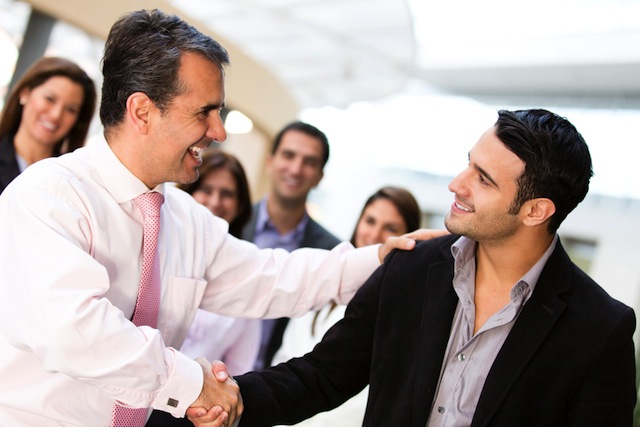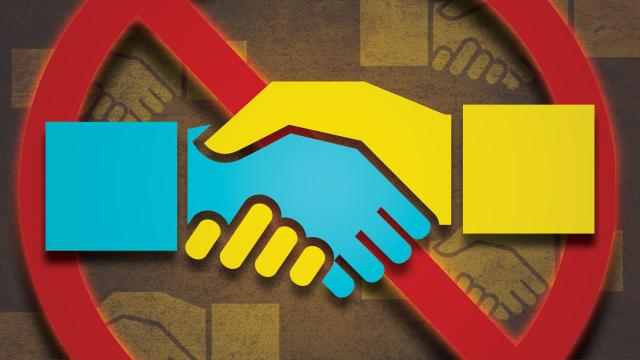At the 40 or so seminars I give yearly, I always ask the same question: “Who here has ever received a bad handshake?” Invariably everyone raises their hands — no surprise there. Perhaps you’ve wondered, as I have, “How can so many people get something so simple as a handshake wrong?” What’s even more startling is how long we remember those bad handshakes.
Handshaking as a form of greeting has been around in some form as long as humans have existed. The warm, reassuring, tactile touch that we as social animals share is essential for social interaction, social harmony, health, survival and security, as well as for communicating our true feelings. Somewhere along the line each culture developed different greetings to communicate how we feel about others — from facial rubbing, to kissing, to hugging, to arm clasping, to the handshake in its many forms.
Handshake Culture

Handshaking is common but not universal. In some cultures, especially around the Mediterranean and the Caribbean, a hug, an air kiss, or an abrazo, are favoured over a handshake, especially among good friends. In other cultures, especially in Asia, a short bow is the more polite greeting, and in the Middle East the woman’s hand is not touched at all unless it is offered by her — even in business settings. In some cultures within cultures, such as in the sporting world, greetings have evolved from the traditional handshake to high-fives to fist bumping. Each society and each culture sets the norm, which can change over time, and yet, if any of these is not performed correctly, it leaves negative impressions.
Think about the thousands of people you meet and each time you shake hands; usually, this is the first time two humans touch. You might not think it’s significant, until you ask around as I did and you find out, business people, friends, acquaintances, are remembering those “bad” handshakes years on. So in an instant, we’re making impressions that have a very long shelf live based on a brief but important handshake.
Bad Handshakes are Hard to Forget
How that handshake is performed is crucial, which is why so many hands go up when I ask who has received a bad one and why it’s usually followed up with comments such as: “it was wet”, “it was creepy”, “eeeeeew”, or they simulate their hand being crushed or handled daintily by the finger tips. Let’s face it, when a handshake is improperly performed, it leaves us with negative feelings about the person who gave us that handshake. And of course if that person is a repeat offender, those negative feelings are just further reinforced.
Why would a bad handshake stay with us for so long? I suspect the answer is multifold and it has to do with evolution and our survival. Consider this: Two strangers meeting on the African savanna, by touching hands together, they demonstrate that they have no weapons — no need to fear each other. By touching hands together properly, chemicals are released in the brain including the bonding chemical oxytocin. Those good feelings help to promote harmony and friendship. Any kind of negativity sensed from the handshake was also important as it would impart information about issues, concerns, or true feelings. Those negative impressions were important because they helped us to formulate a picture of this person we were meeting for the first time.
It makes sense that they would stay with us for a long time; that’s how we evolved. Negative emotions associated with a bad handshake stay with us for so long because it’s stored in that part of the brain (amygdala/hippocampus) that helps us to assess for danger. It’s this area of the brain that helps us to remember, just from one experience, not to touch the hot stove or eat putrid food.
Master the Art of the Shake

So the question is: how do we get it right and what should we avoid? First we have to keep in mind that handshakes are cultural. If you go to Turkey or the Middle East, handshakes may be very gentle — that is a good handshake to them. In Utah you’re going to get a “Mormon handshake”: enthusiastic, vigorous and prolonged. If you go to Bogota, a handshake may be replaced with an abrazo, especially if you’re well liked. The secret to handshaking is to mirror the culture you are in — when in Rome, you do as the Romans.
Here in the United States you get all kinds of handshakes. We have immigrant groups from all over the world and the nation spans six time zones. Handshaking is going to vary along the way, but in business we pretty much have one standard for shaking hands. The hands clasp with equal pressure, fingers down or at a slight angle curling around the other person’s hand so that the index finger and the thumb actually point toward each other on the back side of their hand. This is held just long enough for it to be comfortable and socially acceptable but not too long. At the same time, it’s always good to remember to mirror the handshake of the person who has the highest status — if they give a strong handshake then that’s what you do; conversely if it’s gentle and short then that is also what you do.
The Five Don’ts
It’s not tricky or hard to do, yet some manage to screw it up. Lets go over some things you must not do when shaking hands:
1. Avoid eye contact: Make sure you’re making eye contact with the person with whom you are shaking hands and avoid distractions. I have seen men shaking hands with a corporate manager while the eyes tracked a beautiful woman walking by. Don’t do that — please.
2. Have wet hands: About 2.8 per cent of the population suffers from hyperhidrosis — excessive sweating. Before you shake hands make sure you dry them first. There’s nothing wrong with having a handkerchief in your hand as you wait, or wiping them on the back of the leg just before you shake hands.
3. Be too dominant: Sometime in the 1980s, someone wrote that to establish dominance in a relationship your hand had to be the one on top when shaking hands. The clinical term for this is: crap. Twisting the other person’s hand so that yours is superior or playing hand jujitsu to let the other person know you’re in charge is just rubbish. Don’t do it and if someone does it to you just say, “Let’s do it properly this time without the theatrics this time.” The only thing this kind of handshake achieves is leaving you with a negative impression.
4. Do the “probing” handshake: I hear about or I receive the probing handshake all the time. The probing handshake is where the other person probes you with their index finger pressed against the inside of your wrist. It leaves the most negative of feelings and I’ve had managers, CEOs and HR personnel tell me that for them, it’s the most dreaded handshake. Some have even told me they were “revolted” by it. So, gentlemen (it’s usually done by men) if you erroneously learned this on your own or it’s a part of some sort of secret society ritual, knock it off.
5. Shake like a politician: Lastly, never ever, unless it’s for your grandmother or grandfather, give a politician’s handshake. That’s where you use two hands to cover or cup the other person’s hands. No one likes it — it’s too personal and you have to earn the right to do it. Politicians do it thinking you will like them more — you won’t. If you feel you need to touch more, shake the hand normally and with the other touch the forearm.
So, shaking hands is a simple act that you can get wrong. You’re being assessed when you touch another hand, and you never know if that handshake you’re executing will be long remembered (good or bad).
The Art of Handshaking [Psychology Today]
Joe Navarro is a former FBI Counterintelligence Agent and is the author of What Every Body is Saying. He is an expert on nonverbal communications and body language.

Comments
10 responses to “Avoid These Five Mistakes And Never Give A Bad Handshake Again”
Lol yank article
I’m guilty of something a little more severe than these. I do the “You may shake my hand, peasant” handshake…
Not a good look tbh but I can’t help it :p
I have to be the worst at handshakes. It’s like I have no coordination, I never managed to grasp the hand at the right spot, it’s rather awkward.
Also,
Yes Joe, yes. Maybe next time.
What about the “dead fish” handshake? I worked with a guy who would offer up his hand and it was just a limp, floppy thing, leaving you to do the shaking. It was like trying to hold jelly.
Shake it, then throw it away. They’ll learn to firm up eventually.
The “crusher” has to be worse than the “clammy dead fish”.
A crusher is just a firm handshake when you’re giving a soft one, or at least too soft for theirs.
The best way to avoid a crusher and the pain of one is to ensure your handshake is nice and firm too. Crushers only hurt if they actually crush your hand, where as if you keep your hand firm and strong, it holds its shape, doesn’t get crushed and doesn’t hurt.
Countering a crusher essentially is to fight fire with fire.
Handy tip: I’ve noticed people from the country tend to have the firmest handshakes and are the most likely to provide crushers. They’re the ones I always go the firmest with.
I’ve been told by many people I have an excellent handshake, which I owe to my grandfather and his mate teaching me at a very young age how to shake hands correctly.
The best handshake is when you throw the other person’s hand away like it is a piece of rubbish.
It’s difficult to land, but when timed perfectly, is an excellent way to greet people.
A long time ago I learned that the appropriate response to the dominant handshake was to place your left hand on top and pat his hand in a condescending manner – somewhat like the politician’s handshake you’ve described.
here is an Australian video on the top 10 bad business handshakes.